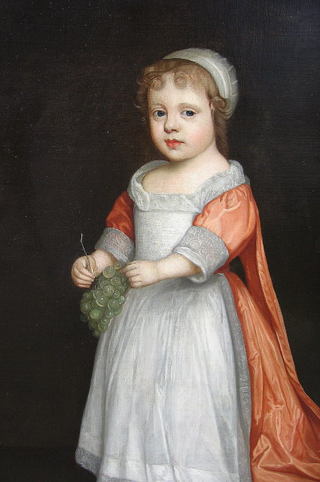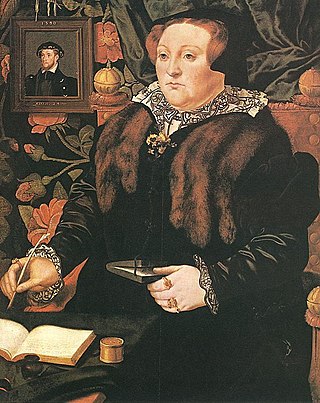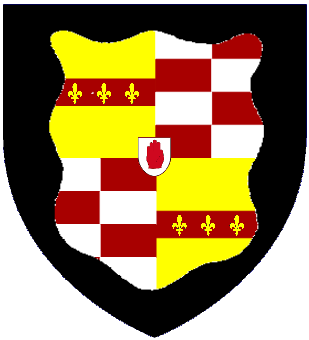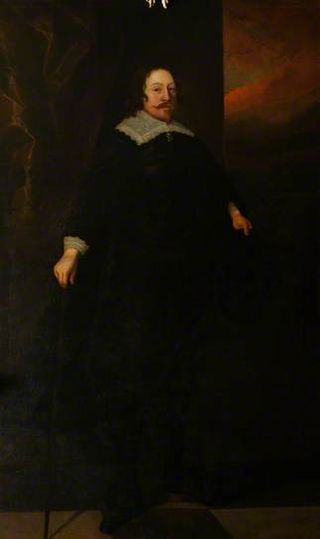
Baron Dacre is a title that has been created three times in the Peerage of England, each time by writ.

Anne Lennard, Countess of Sussex, formerly Lady Anne FitzRoy, was the eldest daughter of Barbara Villiers, mistress to King Charles II. She became the wife of Thomas Lennard, 1st Earl of Sussex.

Herstmonceux Castle is a brick-built castle, dating from the 15th century, near Herstmonceux, East Sussex, England. It is one of the oldest significant brick buildings still standing in England. The castle was renowned for being one of the first buildings to use that material in England, and was built using bricks taken from the local clay, by builders from Flanders. It dates from 1441. Construction began under the then-owner, Sir Roger Fiennes, and was continued after his death in 1449 by his son, Lord Dacre.

Chevening is a village and civil parish in the Sevenoaks District of Kent, England. It was the location for the world's earliest known organised cricket match.

Thomas Fiennes, 9th Baron Dacre was an English nobleman notable for his conviction and execution for murder. He was the son of Sir Thomas Fiennes and Jane, daughter of Edward Sutton, 2nd Baron Dudley.

Mary Fiennes, Baroness Dacre was the daughter of George Neville, 5th Baron Bergavenny by his third wife, Lady Mary Stafford, youngest daughter of Edward Stafford, 3rd Duke of Buckingham.

The Barrett-Lennard Baronetcy, of Belhus in the County of Essex, is a title in the Baronetage of the United Kingdom. It was created on 30 June 1801 for Thomas Barrett-Lennard, subsequently Member of Parliament for Essex South. He was the illegitimate son and testamentary heir of Thomas Barrett-Lennard, 17th Baron Dacre. He was succeeded by his grandson, the second Baronet, the son of Thomas Barrett-Lennard, Member of Parliament for Maldon. His son, the third Baronet, was childless and was succeeded by his younger brother, the fourth Baronet. This line of the family failed on the death in 1977 of his son, the fifth Baronet, who died without male issue. The late Baronet was succeeded by his third cousin once removed, the sixth Baronet. He was the son of Sir Fiennes Cecil Arthur Barrett-Lennard, Chief Justice of Jamaica, son of Captain Thomas George Barrett-Lennard, son of the first marriage of George Barrett-Lennard, son of John Barrett-Lennard, second son of the first Baronet. The sixth Baronet was a Catholic clergyman. As of 2014 the title is held by his second cousin, the seventh Baronet, who succeeded in 2007. He is the grandson of Trenchard Barrett-Lennard, son of the aforementioned George Lennard-Barrett by his second marriage. As of 31 December 2013 the present Baronet has not successfully proven his succession and is therefore not on the Official Roll of the Baronetage, with the baronetcy considered vacant since 2007.
Richard Fiennes, 7th Baron Dacrejure uxoris was an English politician and hereditary keeper of Herstmonceux Castle in Sussex.

Chaloner Chute I of The Vyne, Sherborne St John, Hampshire, was an English lawyer, Member of Parliament and Speaker of the House of Commons during the Commonwealth.

Margaret Fiennes, 11th Baroness Dacre was a suo jure peeress having been created Baroness Dacre by King James I of England in 1604. She was the daughter of Thomas Fiennes, 9th Baron Dacre who was executed for murder in the year of her birth. His title and lands had been forfeited to the crown. Baroness Margaret's husband was Sampson Lennard MP.

Henry Lennard, 12th Baron Dacre was an English baron and politician. He was the son of Margaret Fiennes, 11th Baroness Dacre and Sampson Lennard.
Sir Francis Barnham (1576–1646) was an English politician who sat in the House of Commons at various times between 1604 and 1646. He supported the Parliamentary cause in the English Civil War.
Samson Lennard was an English genealogist, officer of arms, and translator.
Anne Fiennes, Baroness Dacre was an English gentlewoman and benefactress.
Sir Robert More was an English politician who sat in the House of Commons from 1601.
Sir Walter Covert was an English politician who sat in the House of Commons several times during the late sixteenth and early seventeenth centuries.
Sir Nicholas Pelham of Laughton, Sussex was an English politician.
Thomas Colepeper was an English Member of Parliament.
Sir Roger Fiennes (1384–1449) was an English knight of the shire, High Sheriff of Surrey and Sussex, and builder of Herstmonceux Castle. He was also Treasurer of King Henry VI's household.

Sir Thomas Parker of Ratton was an English landowner and politician who sat in the House of Commons between 1626 and 1656. He was elected MP for Hastings in 1626, Seaford in 1641, Sussex in 1656 and was knighted in 1617.










